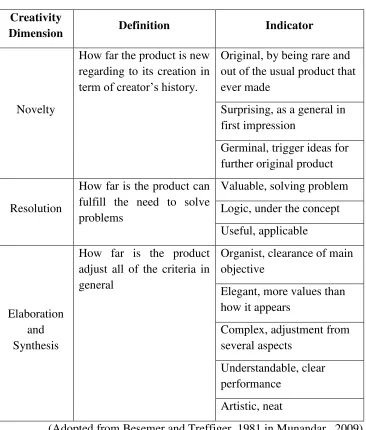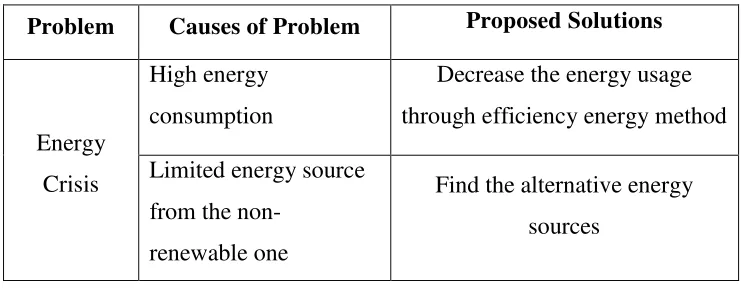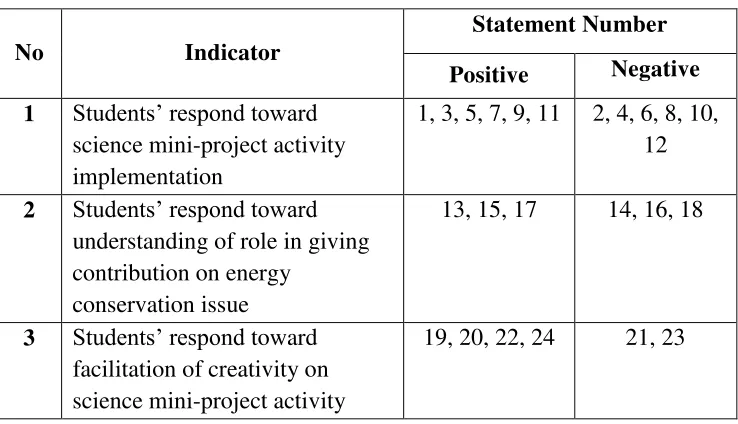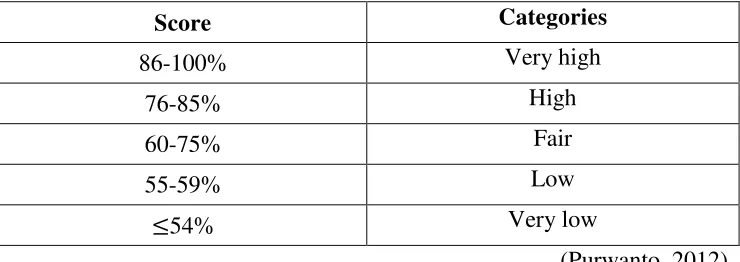22
Adinda Gladya Puspasari , 2014
PROFILE OF STUDENTS’ CREATIVITY AND CONCEPT UNDERSTANDING ON SCIENCE MINI-PROJECT ACTIVITY IN ENERGY CONSERVATION
Universitas Pendidikan Indonesia | repository.upi.edu | perpustakaan.upi.edu
CHAPTER III
METHODOLOGY
A. Research Method and Design
1. Research Method
This research is aimed to investigate current situation of students’ creativity and concept understanding in science mini-project activity, not
including its impact or effectiveness toward students’ achievement. Based
on this, descriptive research method is used to investigate problems and explain why something is occurs. There’s no given treatment or manipulation on object of research. Instead, natural setting condition is captured as a report (Arikunto, 2010).
2. Research Design
Non-experimental with natural descriptive design is used in this research as purposed to provide a description of phenomena. Current situation of research variables are elaborated descriptively and classified based on its types, characteristics, or condition, then draw into conclusion (Arikunto,
2010).
B. Subject of Research
Subject of this research is students of science class in 7th grade in one of the school at Padalarang with number of participant is 19.
Adinda Gladya Puspasari , 2014
PROFILE OF STUDENTS’ CREATIVITY AND CONCEPT UNDERSTANDING ON SCIENCE MINI-PROJECT ACTIVITY IN ENERGY CONSERVATION
Universitas Pendidikan Indonesia | repository.upi.edu | perpustakaan.upi.edu
C. Operational Definition
To avoid the differences in perception, there are explanations about the terms that used in this research, as follows:
1. Students’ Creativity
Creativity is the ability to think about something in novel and unusual ways and come up with unique solutions to problems. Students’ creativity in this research is investigated from the product that created by subject on science mini-project. Students’ creativity is measured by Creative Product Analysis Matrix (CPAM) that developed by Besemer and Treffiger in 1981 under three dimensions: novelty, resolution, and elaboration and synthesis. This creativity scoring is measured on three different conditions; plan as individual, product design as a group, and group presentation by using the development of CPAM rubric scoring as an instrument.
2. Students’ Concept Understanding
Concept understanding in this research is represented as knowledge
related to concept that students need in cognitive process which leads to their ability in solving problem on creative product. Concept understanding is analyzed from students’ elaboration in individual plan,
product design, presentation, and communication book. Students’ concept
understanding explains how students answer the problem under concept related in creative product ideas making and assessed through rubric scoring.
3. Science Mini-Project Activity
Adinda Gladya Puspasari , 2014
PROFILE OF STUDENTS’ CREATIVITY AND CONCEPT UNDERSTANDING ON SCIENCE MINI-PROJECT ACTIVITY IN ENERGY CONSERVATION
Universitas Pendidikan Indonesia | repository.upi.edu | perpustakaan.upi.edu
product in as the outcomes of giving solution. Students will be given a problem to solve in individual and elaborate it in group on next session. The implementation of science mini-project is assessed through observation based on its steps to project-based learning; (1) start with the essential question, (2) design a plan for the project, (3) create schedule, (4) monitor students and project progress, (5) assess the outcome, and (6) evaluate the process.
D. Research Instruments
In order to investigate some points in this research, several research instruments that used are;
1. Rubric Scoring of Students’ Creativity
Students’ creativity is assessed through rubric scoring on three conditions
(individual plan, group product design, and product presentation). Rubric
scoring of students’ creativity is structured under Creative Product
Analysis Matrix (CPAM) from Besemer and Treffiger in 1981 based on its three dimensions; novelty, resolution, and elaboration and synthesis.
2. Rubric Scoring of Students’ Concept Understanding
Students’ concept understanding is assessed from students’ creative
product ideas (individual planning, product design, and presentation)
through rubric scoring. rubric scoring of students’ concept understanding
measured relevancy between students’ creative ideas with concept
covered.
3. Communication Book
Adinda Gladya Puspasari , 2014
PROFILE OF STUDENTS’ CREATIVITY AND CONCEPT UNDERSTANDING ON SCIENCE MINI-PROJECT ACTIVITY IN ENERGY CONSERVATION
Universitas Pendidikan Indonesia | repository.upi.edu | perpustakaan.upi.edu
of problem and purposes, group product design, and mission tracking. Communication book is purposed to track students’ work under project making by ensuring their experience and as one of the source for
analyzing students’ concept understanding (Appendix B.3).
4. Questionnaire
Questionnaire form with gradation range of alternative answers is used to
investigate students’ response and impression in facilitation of creativity
and support their understanding in energy conservation through science mini-project activity.
E. Data Collection
There are several techniques to collect the data needed in this research.
Those data are purposed to fulfill the assessment process of students’
creativity, concept understanding, and investigate students’ response toward science mini-project activity. By this, data collection technique is described below:
1. Data of Students’ Creativity
In order to assess students’ creativity based on their product, this research
used rubric scoring to assess data from students’ product on science
mini-project activity. Rubric scoring is used to assess students’ creativity in group based on their final product under three dimension of CPAM (novelty, resolution, and elaboration and synthesis). Data of students’ creativity are gained from three sources; as individual in planning, as group in product designing, and in group presentation. Blueprint of
students’ creativity rubric scoring based on the dimension of CPAM is
Adinda Gladya Puspasari , 2014
PROFILE OF STUDENTS’ CREATIVITY AND CONCEPT UNDERSTANDING ON SCIENCE MINI-PROJECT ACTIVITY IN ENERGY CONSERVATION
Universitas Pendidikan Indonesia | repository.upi.edu | perpustakaan.upi.edu
Table 3.1 - Blueprint of Creativity Scoring based on its Dimensions
Creativity
Dimension Definition Indicator
Novelty
How far the product is new regarding to its creation in
term of creator’s history.
Original, by being rare and out of the usual product that ever made
Surprising, as a general in first impression
Germinal, trigger ideas for further original product
Resolution
How far is the product can fulfill the need to solve problems
Valuable, solving problem
Logic, under the concept
Useful, applicable
Organist, clearance of main objective
Elegant, more values than how it appears
(Adopted from Besemer and Treffiger, 1981 in Munandar , 2009)
2. Data of Students’ Concept Understanding
Data of students’ concept understanding is gained by analyze students’
product in mini-project that involved the present of cognitive present, which are; elaboration from individual planning, product design, product
presentation, and communication book. Data of students’ concept
Adinda Gladya Puspasari , 2014
PROFILE OF STUDENTS’ CREATIVITY AND CONCEPT UNDERSTANDING ON SCIENCE MINI-PROJECT ACTIVITY IN ENERGY CONSERVATION
Universitas Pendidikan Indonesia | repository.upi.edu | perpustakaan.upi.edu
under concept related in creating creative product ideas. From given
problem about energy crisis, path of students’ learning on mini-project is
expressed by the following blueprint table of students’ concept understanding:
Table 3.2 –Blueprint of Students’ Concept Understanding
Problem Causes of Problem Proposed Solutions
Energy Crisis
High energy
consumption
Decrease the energy usage
through efficiency energy method
Limited energy source from the
non-renewable one
Find the alternative energy sources
3. Data of Students’ Response towards Science Mini-Project Activity
Students’ response which investigated by using questionnaire are;
students’ respond toward science mini-project activity implementation,
students’ respond toward understanding of role in giving contribution on
energy conservation issue, students’ respond toward facilitation of
creativity on science mini-project activity.
Adinda Gladya Puspasari , 2014
PROFILE OF STUDENTS’ CREATIVITY AND CONCEPT UNDERSTANDING ON SCIENCE MINI-PROJECT ACTIVITY IN ENERGY CONSERVATION
Universitas Pendidikan Indonesia | repository.upi.edu | perpustakaan.upi.edu
Table 3.3 - Blueprint of Questionnaire Form
No Indicator
Statement Number
Positive Negative
1 Students’ respond toward
science mini-project activity implementation
1, 3, 5, 7, 9, 11 2, 4, 6, 8, 10, 12
2 Students’ respond toward
understanding of role in giving contribution on energy
conservation issue
13, 15, 17 14, 16, 18
3 Students’ respond toward
facilitation of creativity on science mini-project activity
19, 20, 22, 24 21, 23
F. Data Analysis Technique
Data collected in this research will be analyzed descriptively, as follows:
1. Analysis of Students’ Creativity Data
Students’ creativity is investigated based on their product results from
science mini-project activity. It is measured on three conditions; individual planning, group product, and group presentation. Each part of
students’ creativity indicators are assessed by using rubric scoring under creativity dimension from Besemer and Treffiger, and converted into percentage form through formula as follows:
� = � �
�� � × 100%
Adinda Gladya Puspasari , 2014
PROFILE OF STUDENTS’ CREATIVITY AND CONCEPT UNDERSTANDING ON SCIENCE MINI-PROJECT ACTIVITY IN ENERGY CONSERVATION
Universitas Pendidikan Indonesia | repository.upi.edu | perpustakaan.upi.edu
In order to categorize the students’ creativity, score that gained in percentage form is than classified into 5 types; very high, high, enough, low, and very low as explain in following table:
Table 3.4 - Categories of Creativity Scoring
Score Categories
86-100% Very high
76-85% High
60-75% Fair
55-59% Low
≤54% Very low
(Purwanto, 2012)
Three different datas of students’ creativity are analyzed one by one to
investigate the condition a group, and personal to represent class condition. Students’ achievement in creativity is analyzed based on the three factors that influence creativity; knowledge (from concept understanding), creative thinking based on their working style (from
students’ multiple intelligences profile), and motivation (from students’
response).
2. Analysis of Students’ Concept Understanding
Data collected from students’ elaboration in individual planning, product
design, product presentation, and communication book are structured to
analyze the solution that proposed by students toward issue based on concept related in making creative product ideas. Students’ result of solution in creative product is scored by the following formula:
� � � = � − �
Adinda Gladya Puspasari , 2014
PROFILE OF STUDENTS’ CREATIVITY AND CONCEPT UNDERSTANDING ON SCIENCE MINI-PROJECT ACTIVITY IN ENERGY CONSERVATION
Universitas Pendidikan Indonesia | repository.upi.edu | perpustakaan.upi.edu
Students’ result then interprets into percentage with previous formula for
students’ creativity scoring percentage and analyzed along with the
categorization as the creativity scoring.
3. Analysis of Students’ Response from Questionnaire
The data from questionnaire is used to investigate students’ response toward the implementation of science mini-project activity, support
students’ understanding in energy conservation, and toward facilitation of
creativity. Result from Likert Scale type is score from scale one to five (from strongly disagree to strongly agree), than interpret as the table below:
Table 3.5 – Scoring Guideline of Students’ Response
Strongly
(Adopted from Arikunto, 2010)
After that, each indicator is analyzed based on scoring per items from respondent. Data collected is then scaled per indicator based on the following scale:
(Adopted from Sugiyono, 2013)
Figure 3.1 –Scaling Guideline of Students’ Response Strongly
Agree Agree
Strongly
Disagree Disagree Not Sure
Adinda Gladya Puspasari , 2014
PROFILE OF STUDENTS’ CREATIVITY AND CONCEPT UNDERSTANDING ON SCIENCE MINI-PROJECT ACTIVITY IN ENERGY CONSERVATION
Universitas Pendidikan Indonesia | repository.upi.edu | perpustakaan.upi.edu
G. Research Scheme
Figure 3.2 – Research Scheme Preliminary studies
Literature study of
students’ creativity and
concept understanding
Literature study of science mini-project activity as
project-based learning
Analysis science content for secondary
Research data collection:
Students’ creativity and concept
understanding
Data Processing
Data Analysis
Conclusion
Preparation Stage
Implementation Stage
Final Stage Designing activities and research instruments
Instruments validation
Valid Invalid
Revision





